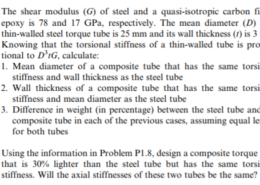Share
P1.8. The shear modulus (G) of steel and a quasi-isotropic carbon fiber epoxy is 78 and 17 GPa, respectively. The mean diameter (D) of a thin-walled steel torque tube is 25 mm and its wall thickness (t) is 3 mm. Knowing that the torsional stiffness of a thin-walled tube is propor- tional to D’IG, calculate 1. Mean diameter of a composite tube that has the same torsional stiffness and wall thickness as the steel tube 2. Wall thickness of a composite tube that has the same torsional stiffness and mean diameter as the steel tube 3. Difference in weight (in percentage) between the steel tube and the composite tube in each of the previous cases, assuming equal length for both tubes P1.9. Using the information in Problem P1.8, design a composite torque tube that is 30% lighter than the steel tube but has the same torsional stiffness. Will the axial stiffnesses of these two tubes be the same?
ReportQuestion
Please briefly explain why you feel this question should be reported.
P1.8. The shear modulus (G) of steel and a quasi-isotropic carbon fiber epoxy is 78 and 17 GPa, respectively. The mean diameter (D) of a thin-walled steel torque tube is 25 mm and its wall thickness (t) is 3 mm. Knowing that the torsional stiffness of a thin-walled tube is propor- tional to D’IG, calculate 1. Mean diameter of a composite tube that has the same torsional stiffness and wall thickness as the steel tube 2. Wall thickness of a composite tube that has the same torsional stiffness and mean diameter as the steel tube 3. Difference in weight (in percentage) between the steel tube and the composite tube in each of the previous cases, assuming equal length for both tubes P1.9. Using the information in Problem P1.8, design a composite torque tube that is 30% lighter than the steel tube but has the same torsional stiffness. Will the axial stiffnesses of these two tubes be the same?

Answer ( 1 )
Please briefly explain why you feel this answer should be reported.